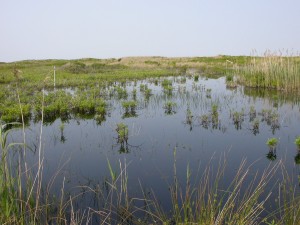In concert with the America’s Great Outdoors (AGO) Initiative, the U.S. Fish and Wildlife Service has approved $2.4 Million in funding to Ohio, Wisconsin and Illinois through the National Coastal Wetland Conservation Grant Program (NCWC). The announcement supports the AGO’s initiative, which takes a grass roots approach to conservation, in that it encourages local innovation to push forward its mission.
Among the 24 projects funded nationwide, three were identified as priorities in the AGO’s 50 State Report. The Illinois Wolf-Lake Powderhorn Lake Connection, one of the three highlighted, will be implemented in the state of Illinois, as a result of a $1 Million grant from NCWC.
“As the Midwest is home to the Great Lakes, the largest group of freshwater lakes on Earth,” said U.S. Fish and Wildlife Service Midwest Region Director Tom Melius, “we have a vast array of freshwater coastal resources to conserve and protect.” Melius continued, “This year’s grants will be critically important in protecting unique Great Lakes coastal wetland habitat important to migratory birds, endangered species, and interjurisdictional fish.”
The following projects in the Great Lakes were approved for funding under NCWC:
Illinois Wolf-Lake Powderhorn Lake Connection (Illinois)
Illinois Department of Natural Resources, in partnership with the Forest Preserve District of Cook County and Openlands, will utilize a $1 million NCWC grant with matching funds in the amount of $2,005,425 to acquire coastal wetlands within the Millennium Reserve in southeast Chicago. Approximately 66 acres will be purchased, with 40.5 acres purchased as part of this grant while an additional 25.15 acres will be purchased with non-grant money. The total acquisition in the Lake Calumet region in Cook County, Ill. will expand the amount of contiguous, protected, coastal wetland and natural areas to approximately 1,200 acres on an important bird migration route. The project area is in a highly urbanized and populated region of the Great Lakes and is a part of the AGO Initiative. Land acquisition in this area will increase opportunities for outreach, education and outdoor recreation in economically disadvantaged and underserved communities in the Chicago area.
Lake Erie Bluffs Preservation Project Phase 4 (Ohio)
The Ohio Department of Natural Resources Office of Coastal Management, in partnership with Lake Metroparks and Western Reserve Land Conservancy, will use a $1 million NCWC grant and $3,000,000 in matching funds to acquire a 209-acre property on Lake Erie. Acquisition of the property will protect important, high quality coastal wetlands that provide habitat for over 25 state-listed species. The Lake Erie Bluffs site is comprised of forested wetlands, high-quality vernal pools and areas of hummock-hollow wetlands. It is estimated that the State of Ohio has lost over 80% of its total wetlands since its settlement. The proposed Lake Erie Bluffs Preservation Project will prevent coastal wetland loss and degradation by permanently preserving 110 acres of nationally declining wetlands and 440 feet of Lake Erie shoreline. This acquisition will also help ensure that one of the last remaining large blocks of wildlife habitat in Lake County, Ohio remains intact. When Lake Metroparks acquires the property, it will grant a permanent conservation easement to the Western Reserve Land Conservancy to ensure that the resources on site remain protected in perpetuity.
Mink River Estuary Coastal Wetlands Protection (Wisconsin)
The Wisconsin Department of Natural Resources, in partnership with The Nature Conservancy, will use a $420,000 NCWC grant and $422,000 in match to purchase 136.36 acres and nearly 2,000 feet of Lake Michigan shoreline within the Mink River Estuary. The Estuary is designated as a State Natural Area and is located in Door County, Wis. Acquisition of this property will provide the long-term protection of 88.65 acres of nationally decreasing coastal wetlands, including 78.76 acres of forested coastal wetland and 9.89 acres of emergent meadow coastal wetland. This project will also protect habitat used by the endangered Hine’s emerald dragonfly and habitat suitable for the threatened dwarf lake iris. Wisconsin’s Wildlife Action Plan identifies the Mink River Estuary as a globally significant Conservation Opportunity Area. Completing this land acquisition project helps fulfill these priority actions.
The National Coastal Wetlands Conservation Grant Program is administered by the U.S. Fish and Wildlife Service and funded under provisions of the 1990 Coastal Wetlands Planning, Protection and Restoration Act. The funding for this program is provided by Sport Fish Restoration Act revenue – money generated from an excise tax on fishing equipment, motorboat and small engine fuels. Under the Program, the Service provides matching grants to States for acquisition, restoration, management or enhancement of coastal wetlands.






